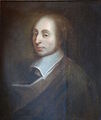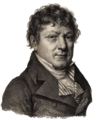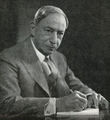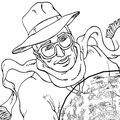Template:Selected anniversaries/August 19: Difference between revisions
No edit summary |
No edit summary |
||
| Line 2: | Line 2: | ||
||1580: Pierre Vernier born ... was a French mathematician and instrument inventor. He was inventor and eponym of the vernier scale used in measuring devices. Pic: device. | ||1580: Pierre Vernier born ... was a French mathematician and instrument inventor. He was inventor and eponym of the vernier scale used in measuring devices. Pic: device. | ||
||1612: The "Samlesbury witches", three women from the Lancashire village of Samlesbury, England, are put on trial, accused of practicing witchcraft, one of the most famous witch trials in British history. | ||1612: The "Samlesbury witches", three women from the Lancashire village of Samlesbury, England, are put on trial, accused of practicing witchcraft, one of the most famous witch trials in British history. Pics. | ||
||1646: John Flamsteed born ... astronomer and academic. Pic. | ||1646: John Flamsteed born ... astronomer and academic. Pic. | ||
| Line 10: | Line 10: | ||
||1692: Salem witch trials: In Salem, Province of Massachusetts Bay, five people, one woman and four men, including a clergyman, are executed after being convicted of witchcraft. | ||1692: Salem witch trials: In Salem, Province of Massachusetts Bay, five people, one woman and four men, including a clergyman, are executed after being convicted of witchcraft. | ||
||1736: Erland Samuel Bring born ... mathematician. | ||1736: Erland Samuel Bring born ... mathematician. Pic. | ||
||1745: Johan Gottlieb Gahn born ... chemist and metallurgist who discovered manganese in 1774. Pic. | ||1745: Johan Gottlieb Gahn born ... chemist and metallurgist who discovered manganese in 1774. Pic. | ||
||1753: Johann Balthasar Neumann dies ... engineer and architect, designed Basilica of the Fourteen Holy Helpers. | ||1753: Johann Balthasar Neumann dies ... engineer and architect, designed Basilica of the Fourteen Holy Helpers. Pic search good: https://www.google.com/search?q=johann+balthasar+neumann | ||
File:Jean-Étienne Montucla.jpg|link=Jean-Étienne Montucla (nonfiction)|1758: [[Jean-Étienne Montucla (nonfiction)|Jean-Étienne Montucla]] received the censor's approbation for his ''Histoire des mathematiques'', which is justly famous as a history of the mathematical sciences. | File:Jean-Étienne Montucla.jpg|link=Jean-Étienne Montucla (nonfiction)|1758: [[Jean-Étienne Montucla (nonfiction)|Jean-Étienne Montucla]] received the censor's approbation for his ''Histoire des mathematiques'', which is justly famous as a history of the mathematical sciences. | ||
| Line 22: | Line 22: | ||
||1785: Seth Thomas born ... clock manufacturer who was one of the pioneers in the mass production of clocks. After working with Eli Terry and Silas Hoadley in firm of Terry, Thomas & Hoadley, which manufactured clocks by mass production methods (1807), Thomas founded a clock factory of his own at Plymouth Hollow, Conn. (1812). He was not an inventive genius, but he was an excellent mechanic and a keen business man. Two years later he paid Terry for the rights to manufacture the latter's popular shelf clock. Shortly, he was selling as many clocks as Terry. As his business developed Thomas built a mill for rolling brass and making wire at Plymouth Hollow, and operated it in conjunction with the clock factory. Finally, he organized the Seth Thomas Clock Co. (1853). Pic. | ||1785: Seth Thomas born ... clock manufacturer who was one of the pioneers in the mass production of clocks. After working with Eli Terry and Silas Hoadley in firm of Terry, Thomas & Hoadley, which manufactured clocks by mass production methods (1807), Thomas founded a clock factory of his own at Plymouth Hollow, Conn. (1812). He was not an inventive genius, but he was an excellent mechanic and a keen business man. Two years later he paid Terry for the rights to manufacture the latter's popular shelf clock. Shortly, he was selling as many clocks as Terry. As his business developed Thomas built a mill for rolling brass and making wire at Plymouth Hollow, and operated it in conjunction with the clock factory. Finally, he organized the Seth Thomas Clock Co. (1853). Pic. | ||
||1790: Edward John Dent born ... clockmaker and inventor whose chronometers were noted for high accuracy. His patents in this field included compasses for navigation and surveying. He experimented with springs made of steel, gold and glass, and devices for counteracting the effects of temperature change upon timepiece mechanisms. As clockmaker to Queen Victoria, he was commissioned to build the Great Clock for the clock tower of the Houses of Parliament (known as Big Ben, although that is actually the nickname of its hour bell) which he began in the year he died. His son, Frederick Dent, completed the work the following year and it was installed in the tower in 1859. It continues to be | ||1790: Edward John Dent born ... clockmaker and inventor whose chronometers were noted for high accuracy. His patents in this field included compasses for navigation and surveying. He experimented with springs made of steel, gold and glass, and devices for counteracting the effects of temperature change upon timepiece mechanisms. As clockmaker to Queen Victoria, he was commissioned to build the Great Clock for the clock tower of the Houses of Parliament (known as Big Ben, although that is actually the nickname of its hour bell) which he began in the year he died. His son, Frederick Dent, completed the work the following year and it was installed in the tower in 1859. It continues to be recognized for its great accuracy of 4 seconds in a year. Pic. | ||
||1808: James Nasmyth born ... engineer who invented the steam-hammer (24 Nov 1839) which was patented in Britain on 9 Jun 1842 (No. 9382). In his early career, Nasmyth improved the design of machine tools. Power hammers had previously been driven by steam, but Nasmyth designed his steam-hammer with more precision and control. The steam functioned to lift the hammer which then dropped by gravity, and repeated the cycle. Nasmyth adapted the idea to make a steam pile-driver. With later improvements, the steam-hammer enabled forging very large guns for the British navy. He became wealthy and in 1856 was able to retire at the age of 48. After retirement, Nasmyth pursued his hobby of astronomy, in which he published minor works. Pic. | ||1808: James Nasmyth born ... engineer who invented the steam-hammer (24 Nov 1839) which was patented in Britain on 9 Jun 1842 (No. 9382). In his early career, Nasmyth improved the design of machine tools. Power hammers had previously been driven by steam, but Nasmyth designed his steam-hammer with more precision and control. The steam functioned to lift the hammer which then dropped by gravity, and repeated the cycle. Nasmyth adapted the idea to make a steam pile-driver. With later improvements, the steam-hammer enabled forging very large guns for the British navy. He became wealthy and in 1856 was able to retire at the age of 48. After retirement, Nasmyth pursued his hobby of astronomy, in which he published minor works. Pic. | ||
| Line 32: | Line 32: | ||
||1830: Julius Lothar Meyer born ... chemist who discovered the Periodic Law, independently of Dmitry Mendeleyev, at about the same time (1869). However, he did not develop the periodic classification of the chemical elements as thoroughly as Mendeleyev. Meyer trained originally in medicine and chemistry. He examined the effect of carbon monoxide on blood. In 1879, Meyer compared atomic volume to atomic weight. Plotted on a graph, the curve showed the periodicity of the elements. He also established the concept of valency by indicating that a given element combined with a characteristic number of hydrogen atoms, and coined the terms like univalent, bivalent, and trivalent, based on that number. Pic. | ||1830: Julius Lothar Meyer born ... chemist who discovered the Periodic Law, independently of Dmitry Mendeleyev, at about the same time (1869). However, he did not develop the periodic classification of the chemical elements as thoroughly as Mendeleyev. Meyer trained originally in medicine and chemistry. He examined the effect of carbon monoxide on blood. In 1879, Meyer compared atomic volume to atomic weight. Plotted on a graph, the curve showed the periodicity of the elements. He also established the concept of valency by indicating that a given element combined with a characteristic number of hydrogen atoms, and coined the terms like univalent, bivalent, and trivalent, based on that number. Pic. | ||
||1839: Louis Daguerre announces the invention of the daguerreotype photographic process, the first process to allow an image to be chemically fixed as a permanent picture. On 7 Jan 1839 an announcement was made of the discovery, but details were not divulged until 19 Aug, when the process was announced publicly, and the French government having bought the rights to the process from him, freely gave them to the world. However, this process had also been patented in England and Wales on 14 Aug 1839, only five days previously. | ||1839: Louis Daguerre announces the invention of the daguerreotype photographic process, the first process to allow an image to be chemically fixed as a permanent picture. On 7 Jan 1839 an announcement was made of the discovery, but details were not divulged until 19 Aug, when the process was announced publicly, and the French government having bought the rights to the process from him, freely gave them to the world. However, this process had also been patented in England and Wales on 14 Aug 1839, only five days previously. Pic. | ||
||1854: The First Sioux War begins when United States Army soldiers kill Lakota chief Conquering Bear and in return are massacred. | ||1854: The First Sioux War begins when United States Army soldiers kill Lakota chief Conquering Bear and in return are massacred. Pics. | ||
||1856: Charles Frédéric Gerhardt dies ... chemist. Pic. | ||1856: Charles Frédéric Gerhardt dies ... chemist. Pic. | ||
| Line 40: | Line 40: | ||
||1865: Hantaro Nagaoka born ... physicist and a pioneer of Japanese physics during the Meiji period. Pic. | ||1865: Hantaro Nagaoka born ... physicist and a pioneer of Japanese physics during the Meiji period. Pic. | ||
||1871: Orville Wright, American engineer and pilot, co-founded the Wright Company. | ||1871: Orville Wright, American engineer and pilot, co-founded the Wright Company. pic. | ||
||1876: George Smith dies ... archaeologist and Assyriologist who translated Babylonian cuneiform tablets (1872) describing a great deluge, part of the Gilgamesh epic, and akin to that found in Genesis. Smith, as an apprentice banknote engraver since age 14, spent much of his own time teaching himself how to decipher cuneiform, by studying inscriptions available at the British Museum. His skill was recognized, and he worked for the British Museum from 1867. Smith engaged in fieldwork in 1873 at Nineveh (Kuyunjik) finding more tablet fragments of the flood story, and others on the Babylonian dynasties. He published his work in The Chaldean Account of Genesis (1876). He died at age 36 of a fever while excavating more of Assurbanipal's library. Pic. | ||1876: George Smith dies ... archaeologist and Assyriologist who translated Babylonian cuneiform tablets (1872) describing a great deluge, part of the Gilgamesh epic, and akin to that found in Genesis. Smith, as an apprentice banknote engraver since age 14, spent much of his own time teaching himself how to decipher cuneiform, by studying inscriptions available at the British Museum. His skill was recognized, and he worked for the British Museum from 1867. Smith engaged in fieldwork in 1873 at Nineveh (Kuyunjik) finding more tablet fragments of the flood story, and others on the Babylonian dynasties. He published his work in The Chaldean Account of Genesis (1876). He died at age 36 of a fever while excavating more of Assurbanipal's library. Pic. | ||
| Line 89: | Line 89: | ||
||1960, the first commercial atomic energy reactor, and the third in the U.S., achieved a self-sustaining nuclear reaction. It began producing power for distribution on 10 Nov 1960. This was the $57 million Yankee Atomic Electric Company's plant at Rowe, Mass., on the Deerfield River. The pressurized light-water reactor produced 125,000 kilowatts of electricity. The company was formed by twelve New England utility companies which signed a contract with the Westinghouse Corporation as the principal contractor. It was permanently shut down on 26 Feb 1992, due to reactor vessel embrittlement, after more than 31 years of service. Decommissioning began in 1993. | ||1960, the first commercial atomic energy reactor, and the third in the U.S., achieved a self-sustaining nuclear reaction. It began producing power for distribution on 10 Nov 1960. This was the $57 million Yankee Atomic Electric Company's plant at Rowe, Mass., on the Deerfield River. The pressurized light-water reactor produced 125,000 kilowatts of electricity. The company was formed by twelve New England utility companies which signed a contract with the Westinghouse Corporation as the principal contractor. It was permanently shut down on 26 Feb 1992, due to reactor vessel embrittlement, after more than 31 years of service. Decommissioning began in 1993. | ||
||1964: Hans Peter Luhn dies ... researcher in the field of computer science, and, Library & Information Science for IBM, and creator of the Luhn algorithm, KWIC (Key Words In Context) indexing, and Selective dissemination of information ("SDI"). Pic search good: https://www.google.com/search?q=hans+peter+luhn | |||
||1964: Syncom 3, the first geostationary communication satellite, is launched. | ||1964: Syncom 3, the first geostationary communication satellite, is launched. | ||
Revision as of 05:28, 1 March 2019
1662: Mathematician, physicist, inventor, writer, and Christian philosopher Blaise Pascal dies. He did pioneering work on calculating machines.
1758: Jean-Étienne Montucla received the censor's approbation for his Histoire des mathematiques, which is justly famous as a history of the mathematical sciences.
1822: Mathematician and astronomer Jean Baptiste Joseph Delambre dies. He was one of the first astronomers to derive astronomical equations from analytical formulas.
1823: Red Eyes Fighting depicts martial artist and crime-fighter Red Eyes breaking up a math lab.
1906: Inventor Philo Farnsworth born. He will make many crucial contributions to the early development of all-electronic television.
1923: Engineer, sociologist, economist, political scientist, and philosopher Vilfredo Pareto dies. He applied mathematics to economic analysis, asserting that the distribution of incomes and wealth in society is not random and that a consistent pattern appears throughout history, in all parts of the world and in all societies.
1967: Inventor, writer, editor, and publisher Hugo Gernsback dies. He published the first science fiction magazine, and had a profound influence on the development of science fiction.
1993: Actor-cryptographer Niles Cartouchian confirms that he personally designed the computational security protocols featured in the action-adventure film Dard Hunter, Glyph Warden.
1994: Chemist, biochemist, peace activist, author, and educator Linus Pauling dies.
2015: A giant red ball breaks loose from an art installation and rolls down the street in Toledo, Ohio.
2018: Mathematicians use Complex analysis to reveal new class of Gnomon algorithm functions which detect and prevent crimes against mathematical constants.










